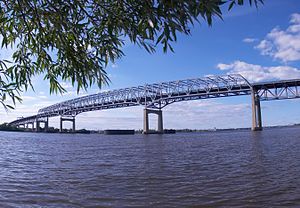Betsy Ross Bridge
| Betsy Ross Bridge | |
|---|---|

The continuous truss structure of the Betsy Ross Bridge
|
|
| Coordinates | 39°59′09″N 75°04′00″W / 39.98595°N 75.06676°WCoordinates: 39°59′09″N 75°04′00″W / 39.98595°N 75.06676°W |
| Carries | 6 lanes of NJ 90 |
| Crosses | Delaware River |
| Locale | Philadelphia (Bridesburg), Pennsylvania and Pennsauken Township, New Jersey |
| Official name | Betsy Ross Bridge |
| Other name(s) | Ross Memorial Bridge |
| Maintained by | Delaware River Port Authority of Pennsylvania and New Jersey |
| ID number | 4500011 |
| Characteristics | |
| Design | Steel Continuous truss bridge |
| Total length | 8,485 feet (2,586 meters) |
| Width | 105 feet 4 inches (32.11 meters) |
| Longest span | 729 feet (222 meters) |
| Clearance above | 37.66 feet (11.48 meters) |
| Clearance below | 135 feet (41 meters) |
| History | |
| Construction cost | $103 million |
| Opened | April 30, 1976 |
| Statistics | |
| Daily traffic | 39,980 (2000) |
| Toll | $5.00 (westbound) (E-ZPass) |
The Betsy Ross Bridge, also known as the Ross Memorial Bridge is a continuous steel truss bridge spanning the Delaware River from the City of Philadelphia in Pennsylvania to Pennsauken, New Jersey. Built from 1969 to 1974, and opened in April 1976, during the American Bicentennial Year, it was originally planned to be named as the "Delair Bridge", after a paralleling vertical lift bridge owned by Pennsylvania Railroad (which is now used by Conrail and New Jersey Transit's Atlantic City Line), but was instead later named for Betsy Ross, a Philadelphia seamstress and reputed creator of the first American flag in 1776, making it the first automotive bridge named for a woman in America and the second bridge overall (after Iowa's Boone High Bridge was renamed the Kate Shelley High Bridge in 1912).
Construction began in 1969, and was completed in 1974. However, the bridge did not open to traffic until April 30, 1976 due to numerous problems with the communities where the bridge's ramps to and from Richmond Street were located. The problems (concerns over traffic, especially heavy trucks) were also related to the highway route's planned extension to the northwest from the Delaware River, across Northeast Philadelphia to connect with the Roosevelt Expressway. The cancellation of this extension, the planned Pennsylvania Route 90 (PA 90 - known as the Pulaski Expressway) resulted in the so-called "Evel Knievel" ghost ramps – with unfinished bridges and fly-over ramps, some of which were later constructed to serve nearby Aramingo Avenue in the city's Bridesburg section. Currently, the route serves as a high-level multi-lane (six lanes, separated by a concrete median barrier) bypass of the three-lane Tacony-Palmyra Bridge, which has a drawbridge on the span.
...
Wikipedia
